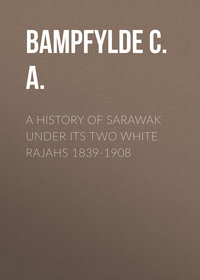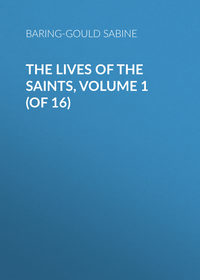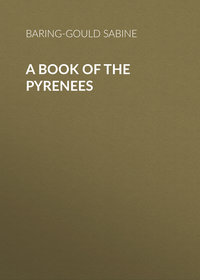 полная версия
полная версияA Book of North Wales
They did so. The King’s Council was satisfied, and Catherine married Owen, and became, by him, the mother of Edmund “of Hadham,” who was created Earl of Richmond by Henry VI. in 1453.
His son, Edmund Tudor, married Margaret, daughter of John Beaufort, Duke of Somerset, and great-granddaughter of “old John of Gaunt, time-honoured Lancaster,” and so became the father of Henry VII.
Queen Catherine died in 1437, leaving, beside Edmund, a son Jasper, and another Owen, who embraced a monastic life and died early.
As soon as the queen was dead bad times ensued for Owen. The marriage had been winked at, but not relished, and he was seized and committed to Newgate, and the three sons were given into the custody of the Abbess of Barking.
Aided by his chaplain and a servant, Owen effected his escape, but he was retaken and delivered to the Earl of Suffolk to be kept in Wallingford Castle; but he was transferred to Newgate. He made his escape a second time.
In the year 1453 his sons were both made earls – Edmund was created Earl of Richmond and Jasper Earl of Pembroke. Owen had an illegitimate son, named David, who was knighted by his nephew, Henry VII.
Owen remained unnoticed till 1459, when his own son Jasper graciously conferred knighthood on him. Henry VI. granted him some lands and a revenue, but a law was passed that henceforth no commoner, under severe penalties, should presume to marry a queen dowager of England without special licence from the king.
In 1461 he fought under the banner of his son Jasper at the battle of Mortimer’s Cross, and would not quit the field, but was taken with several other Welsh gentlemen, and was beheaded soon after at Hereford.
Jones, in his Relicks of the Welsh Bards, 1794, gives a duet which purports to be translated from the Welsh, and which is based on the wooing of Owen Tudor and Catherine. He does not give the original Welsh. The air as well as the words has a very modern smack.
The duet begins: —
“Owen.I salute thee, sweet Princess, with title of grace,For Cupid commands me in heart to embraceThy honours, thy virtues, thy favour, thy beauty,With all my true service, my love, and my duty.Catherine. Courteous, kind gentleman, let me request,How comes it that Cupid hath wounded thy breast?And chanc’d thy heart’s liking my servant to prove,That am but a stranger to this, thy kind love?”And it all winds up with their saying together: —
“Then mark how the notes of our merry town bells,Our ding-dong of pleasure most cheerfully tells.Then ding-dong, fair ladies, and ladies all true,This ding-dong of pleasure may satisfy you.”Actually it would seem that the spooning was on the side of the Queen and not of Owen.
The house of Penmynydd dates from 1370, and is consequently the same as that visited by the commission. The kitchen is intact, and the Tudor arms are carved about the building, and there still is the courtyard in which the ancestress of King Edward VII. sat shelling peas into a bowl when the deputation arrived.
Wales is supposed to have provided a grandmother to queens Mary and Anne, a pot-girl, who married the brewer whose tubs she scoured, so soon as his wife died. But the story is as apocryphal as that of the smuggling into the palace of James II. of a surreptitious Prince of Wales in a warming-pan.
The Protestant party got up this latter scandalous fable, and Mary of Modena and the Roman Catholic faction retaliated with the tale of the Welsh pot-girl.
The story was this. It was confidently asserted that the wife of the celebrated Lord Clarendon was a bare-footed Welsh lass who had gone to London for service and found employment as a “tub-woman” to a brewer and publican there, who subsequently married her, and on his death bequeathed to her a large fortune. As the succession was disputed by his relations, she sought the professional assistance of the lawyer Edward Hyde, who introduced her to his family, and his son Edward married her. She became the mother of Anne, whom James Duke of York married. Her granddaughters Mary and Anne wore the crown.
But the story is contradicted by facts. Edward Hyde, who became Earl of Clarendon and High Chancellor of England, married Anne, daughter of Sir George Ayliffe, knight. Six months afterwards she died of small-pox, and childless. Then he married Frances, daughter of Sir Thomas Aylesbury, knight, and by her became the father of Mary and Anne.
Burke, in his Romance of the Aristocracy, tells the story somewhat differently. He makes the pot-girl marry Sir Thomas Aylesbury, by whom she had a daughter Frances, who married Edward Hyde.
But this story also breaks down. For it is certain that the wife of Sir Thomas Aylesbury was the daughter of Francis Denman, rector of West Retford, and widow of William Darell.
As far as can be ascertained there is not even a substratum of truth in the story.
Carnarvon lies at a little distance from the old Roman town of Segontium, or Caersaint, as the British called it. The river that flows into the sea beneath the castle walls is the Seiont, or Saint. It was here that resided Elen the Road-maker, daughter of Eudaf, chieftain of Erging and Ewyas, who married the usurper Maximus, called by the Welsh Maxen Wledig. This Roman general was raised to the purple by the legions in Britain in 383. He was by birth a Spaniard, and had acquired a reputation under the elder Theodosius in a campaign against the Picts and Scots in 368.
According to Welsh tradition he was a humane ruler, who showed favour to the native British. Unfortunately for himself and for Britain, Maximus did not content himself with recognition as king in Britain, but aspired to be emperor in Rome. He assembled a large army of native levies, prepared a fleet, crossed the Channel. His wife’s brother or cousin, Cynan Meiriadog, a ruler whose home was near S. Asaph, threw in his lot with him, and led to his assistance the flower of the youth of Britain.
Maximus established himself at Trèves, and his wife, who was a pious woman, gave up the imperial palace there to be made into a church. At Trèves she has been confounded with Helena, mother of Constantine, who never was there at all. This misconception has been made to serve as a basis for the myth of the “Holy Coat,” the seamless robe of Christ, which she is supposed to have brought from Jerusalem and to have given to the church of Trèves, where it is preserved as an inestimable relic and exposed at long intervals. Maximus was finally defeated and killed at Aquileia in 388. His followers dispersed, and Cynan Meiriadog and his young bucks never saw again their native land. “Britain,” says Gildas, “was thus robbed of her armed soldiery, of her military supplies, of her rulers, of her vigorous youth who had followed the footsteps of the above-mentioned military tyrant, and who never returned.”
What became of Elen after the death of Maximus can only be inferred. Probably she escaped from Trèves and came back to her native Wales. She has been credited by the Welsh with the great paved roads that traverse the Principality in all directions, and they bear her name as Sarnau Helen.
The noble castle of Carnarvon was begun by Edward I., and is picturesque, but not equal to Conway. In it Edward “of Carnarvon,” who succeeded to the throne, was born. He was invested with the Principality of Wales after the extinction of the race of Cunedda in blood.
Visitors are shown a room in the Eagle Tower as that in which Edward first saw the light; but this tower was not erected till later, though the castle itself was begun in 1284. It was not completed till 1322. There had, however, been a fortress here before, erected by Hugh the Wolf, or the Fat, Earl of Chester. This Hugh and his namesake, the Earl of Shrewsbury, were unsparing in their cruelties to the Welsh. If Hugh of Chester was a wolf in his ferocity, he was a fox in guile. He inveigled the king of Gwynedd into a conference, then treacherously imprisoned him, and the king languished in a dungeon for twelve years, to 1098. Hugh was sister’s son to William the Conqueror, who delivered over Wales to him to rifle at an annual rental of £40.
Gruffydd, king of Gwynedd, escaped in 1098, and at once threw himself into Anglesey. The two Hughs marched against him from Carnarvon as their base, and entered Mona. What had happened before, and was to happen again and yet again, occurred now. At the supreme moment Gruffydd flew to Ireland, and Anglesey was at the mercy of the two Hughs. They set to work to destroy the crops, burn the houses, and slaughter the inhabitants in cold blood, after all resistance had come to an end. When weary of killing, they tore out the tongues, scooped out the eyes, and hacked off the feet and hands of the peasantry, out of mere lust of torture.
It so chanced that at this juncture a Viking fleet appeared off the coast, under Magnus Barefeet of Norway, and Hugh the Fat of Chester and Hugh the Proud of Shrewsbury advanced to the coast to oppose the landing of the Northmen. On board the king’s ship was Magnus of Orkney, a pious, feeble youth. The Norse king bade him arm for the fight.
“No,” replied the young man, “I will not hurt those who have not hurt me.”
“Then go down, coward, into the hold,” said Magnus Barefeet wrathfully. The young prig took his psalter and obeyed. And as the battle raged above him, his voice could be heard above the din of arms repeating the psalms.
The two earls were on the coast near Beaumaris, where it shelves into the sea, riding up and down urging on their men.
“Then,” says the Icelandic Saga writer, “King Magnus shot with his bow, but Hugh was clad in armour, and nothing was bare about him save one eye. King Magnus let fly an arrow at him, as did also a Halogolander at his side. They both shot at once, one arrow struck the nose-screen of the helm and glanced aside, but the other entered the earl’s eye and penetrated his head, and that was afterwards recognised as the king’s arrow.”
When the shaft struck him, Earl Hugh leaped into the air. “Ah, ha!” shouted King Magnus, “let him skip.”
The Hugh who fell was Hugh of Shrewsbury.
The Norsemen came ashore, but finding Anglesey already ravaged, re-entered their boats and spread sail.
The Magnus who would not fight, but sat in the hold singing psalms, is he to whom the cathedral of Kirkwall, in Orkney, is dedicated.
From Bangor, Plas Newydd, the seat of the Marquess of Anglesey, may be visited. The grounds are fine, and there is good timber in the park, but the house is naught. More interesting is Plas Côch, a fine example of an Elizabethan house, built by Hugh Hughes, Attorney-General in the sixteenth century.
In the grounds of Plas Newydd are two cromlechs, or rather what the French would call allées couvertes. They are prehistoric tribal mausoleums, and are perhaps the finest in the Principality. The cap stone of one is 14 feet long by 13 feet broad, and from 3 to 4 feet thick. There are vast numbers of cromlechs in Anglesey, but year by year sees the number decrease. By the Highway Act of William IV. (1835) the road surveyor may enter on any waste or common and dig and search for stone and remove the same. He may also take stones from any river. He may go into another parish and do as above, provided he leaves sufficient stone for the said parish. He may enter enclosed land, with the consent of the owner, and remove stone, paying nothing for the same, but paying for any damage caused by transportation of the stone. If the owner refuses consent, the surveyor may apply to the nearest justice, who may authorise him to enter the enclosed land and remove any stone he requires. Farmers are only too delighted to have cromlechs and other prehistoric stone monuments blown up with dynamite and cleared off. Then visitors will not trespass to see them, and all obstruction to cultivation will be removed. Recently a number have been destroyed in Anglesey and elsewhere. They are being used up for roads. The cromlech, kistvaen, and allée couverte were tombs. Usually a stone was left to be removed, or a plug was inserted in a holed stone, that could be taken out at pleasure, to enable the living to enter the tomb and thrust back the skeletons that were old to make room for new interments. Perhaps also food for the dead was passed in to them through these holes.
On a day in the year, we know not what day it was, but probably at Samhain, the Feast of the Underground Spirits, corresponding to our All Souls’ Day, a great banquet was held in commemoration of dead ancestors, and then the bones of the resurrected parents and grandparents were brought out, fondled, scraped, and cleaned up, and then reconsigned to the family tomb. The family or tribal mausoleum was the centre round which the family or tribe revolved. All the religion of these Neolithic and Bronze Age people centred in their dead and in the world of spirits. We find among the Welsh, that all their tribal rights depended on the preservation of their pedigrees. It was the same idea in another form.
We, in our matter-of-fact and of to-day world, think nothing of our forbears. I believe it was Swedenborg who said that Europe had still a great lesson to learn – he did not specify it – and that this lesson would be taught it by the Turanian race. Perhaps the Chinaman will play his part in the future, and he will bring to us Westerns the doctrine of the reverence due to the old people from whose lives we derive our physical and spiritual and mental powers.
Monier-Williams, in his Brahminism and Hinduism (1887), says: —
“The neglect of our ancestors, which seems to spring not so much from any want of sympathy with the departed as from an utter disbelief in any interconnexion between the world and the world of spirits, is by some regarded as a defect in our religious character and practice.”
We have lost a great tie to those who have gone before in the neglect of commemoration of the dead and realisation of the Article of the Faith, the Communion of Saints. Our modern civilisation, our culture, our manliness, our refinement, we owe to the straining after an ideal, not always attained, but seen and sought by those who have predeceased us. We do not make ourselves, we have been made and moulded into what we are by the good old folk who are to us only names in our pedigree. If the sins of fathers are visited on their children, and of this there can be no doubt, so also do their virtues descend, and we owe them something, some recognition, some kindly thought, some remembrance in our commune with God, on that account.
So these cromlechs and kistvaens may teach us something. Anglesey and Carnarvonshire abound in these monuments, and Mr. J. E. Griffith, of Bangor, has published a splendid work on them, with photographic plates representing such as remain.
From Carnarvon Llanddwyn may best be visited. To the south-east of Anglesey is a tract of blown sand from Newborough – in Welsh Rhosyr. A spit of land runs out into the sea, and bears a lighthouse that sheds its warning ray over the southern entrance to the Menai Straits. It encloses a bay, and the sands extend thence to the Straits.
On this tongue of land stand the ruins of a church founded by S. Dwyn or Dwynwen, daughter of Brychan, the Irish king of Brecknock. The place is not easily reached from Newborough without a guide, as the sands are over ankle, and in places half-way up the calf, deep, and the labour of reaching it is great to anyone who does not know the track. Yet the place was at one time greatly resorted to. Dwynwen was the Venus of Wales. She and one Maelor Dafodril fell desperately in love with each other, but when he paid her his addresses, in a spirit of caprice or levity she flouted him, and he retired deeply offended. She constantly expected him to return, but he did not; instead, he published libels about her. She was miserable, partly because of these slanders, partly because she loved him still. Then in her distress she prayed to be relieved of her passion, and an angel appeared and administered to her some drops of a heavenly liquid, and at once her heart was cured of love-sickness.
Next the angel administered the same medicine to Maelor, and he was congealed to ice. God now gave to Dwynwen three requests which He undertook to fulfil. So she asked to have Maelor thawed, and he was so; then she asked that all lovers who invoked her aid might obtain the object of their desires, or become indifferent; then, lastly, she asked that she might never again hanker after the married estate.
At Llanddwyn was a holy well that is now choked by sand, but till it was smothered up was in much resort for its oracular answers to questions put to it. The following is an account of the ceremony from the pen of William Williams, of Llandegai, written about 1800: —
“There was a spring of clear water, now choked up by the sand, at which an old woman from Newborough always attended and prognosticated the lover’s success from the movements of some small eels, which waved out of the sides of the well on spreading the lover’s handkerchief on the surface of the water. I remember an old woman saying that when she was a girl she consulted the woman at the well about her destiny with respect to a husband. On spreading her handkerchief, out popped an eel from the north side of the well, and soon after another crawled from the south side, and they both met on the bottom of the well. Then the woman told her that her husband would be a stranger from the south part of Carnarvonshire. Soon after, it happened that three brothers came from that part and settled in the neighbourhood where this young woman was, one of whom made his addresses to her, and in a little time married her. So much of the prophecy I remember. This couple was my father and mother.”
A maxim attributed to the saint is, “There is no amiability like cheerfulness”; i. e. Nothing is so attractive as a cheerful spirit. S. Dwynwen was also regarded as patroness of the cattle in Anglesey. The same writer adds: —
“I remember hearing an instance which happened, I believe, about one hundred and fifty years ago. The ploughing oxen at Bodeon, on April 25th, took fright when at work, and ran over a steep rock and perished in the sea. This being S. Mark the Evangelist’s Day, it was considered that having done work on it was a transgression of a divine ordinance, and to prevent such accident for the future the proprietor of the farm ordered that this festival of S. Mark should be for the future invariably kept a holy day, and that two wax candles should annually on that day be kept burning in the church porch of Llanddwyn, which was the only part of the building that was covered in, as an offering and memorial of this transgression and accident, and as a token that S. Dwynwen’s aid and protection was solicited to prevent such catastrophe any more. This was only discontinued about eighty years ago, i. e. 1720.”
The Penrhyn slate quarries are reached by a branch line from Bangor to Bethesda. The quarrying is carried on upon a vast scale, and the place is interesting to the geologist on account of the presence, in the midst of a great dyke of greenstone, of an eruptive rock which has traversed the beds, and which has been left untouched.
The slates are cut to various sizes. Duchesses are the largest; then come Countesses and Ladies. About the beginning of last century a slate merchant of the name of Docer, going through the quarry with Lord Penrhyn, advised him that the slates should be made of such-and-such a size, and this is the origin of the name of “Docer.” By this time the skill of the quarryman and of the slater found some new plan continually. One wanted to do this, and another that. His lordship failed to please everybody. His lady, seeing him in this plight, and in continual trouble, advised him to call the slates after the names of the degrees in the aristocracy. He took up the suggestion, and called the 24 by 12 slate a Duchess, the 20 by 10 a Countess, and the 16 by 8 a Lady.
This has given occasion to some witty verses by an old Welsh judge, Mr. Leycester, and I venture to quote a few of them, though they have already been enshrined in that most delightful of all handbooks, The Gossiping Guide.
“It has truly been said, as we all must deplore,That Grenville and Pitt have made peers by the score;But now, ’tis asserted, unless I have blundered,There’s a man who makes peeresses here by the hundred.By the stroke of a hammer, without the King’s aid,A Lady, or Countess, or Duchess is made.And where’er they are seen, in a palace or shop,Their rank they preserve, they are still at the top.This Countess or Lady, though crowds may be present,Submits to be dressed by the hands of a peasant,And you’ll see, when Her Grace is but once in his clutches,With how little respect he will handle a Duchess.”An interesting example has been observed in the quarries of the direction in which a seismic wave passes. The slates are arranged in a long series. When a shock of earthquake comes it has been noticed that the slates click, click, click in succession, showing the course taken by the vibration of the earth, from east to west or from north to south.
The quarry presents a busy scene. A horn gives the signal for the blasting. When it sounds, at once the workmen disappear under sheds, till the explosion is over with its consequent rush and rattle of débris.
At Penrhyn died quite recently an old workman, Albert Davies, whose life’s story may be told, as it illustrates the intellectual and especially the theological bent of the Welsh mind. This mind is speculative and disputative, and it exercises itself by choice in political and theologic fields.
Albert Davies in his early years was a collier in South Wales, a member of a Calvinistic Methodist family, and could speak no other tongue but Welsh. From boyhood his great craving was for books, and, above all, for books that treated of sacred matters. In the dinner-hour it is very general for miners, quarrymen, and labourers to argue points of divinity, and Davies became a strong controversialist against the Unitarian and Socinian notions which were gaining ground among his associates. By degrees an idea germinated in his brain that as Calvin, Wesley, Luther, and other great founders had created organisations to maintain and propagate their opinions, so, in all probability, the great Founder of Christianity had formed a corporate body to carry on His teaching unto the end of time. He had never been brought into direct contact with the Church of England, and had an inherited prejudice against it, as purely English, and as representing Saxon domination over Wales, and he could think of no Body that would answer his requirements but the Roman Church. He accordingly took up the study of its teaching and claims, and became convinced that if Christ did found a community, it must be the Catholic Church, which the Roman Body asserted itself to be; and Davies was received into that communion.
After some years, however, his confidence gave way; he found, as he thought, too much credulity, too great demands made on faith; and he took to a study of the Fathers.
Then his faith gave way; he separated from the Roman Communion, and for a while was adrift in his convictions. He left the colliery in which hitherto he had worked, and wandered from place to place in bitterness of spirit, taking up occasional work here and there, unsettled in every way, spiritually as well as temporally.
After a while he settled as a quarryman at Penrhyn, and here for the first time came in contact with Anglican clergy, and found that the Church of England, while not pretending to be the whole Church, considered herself to be part and parcel of the One Body, with the sacred deposit of faith, orders, and sacraments. This gave him what he wanted, and Albert Davies now found his feet on what he thought was solid ground, and the old argumentative spirit reawoke in him, and the dinner-hour was once more the time for theological dialectics.
So years passed, and old age and ill-health crept on. The quarry work that he could do was ill-paid and precarious. He lived in chronic hunger, and often was too poor to afford himself a fire in winter; for every penny he could spare was spent in the purchase of books. He would read none but such as dealt with theology.
At length he became so ill that he had to be taken into the workhouse. He struggled against the necessity as long as he could, and then submitted, saying, “It is God’s will, and I must accept what He desires.”









